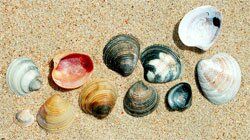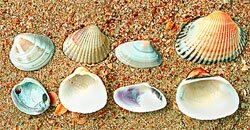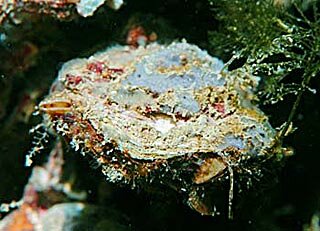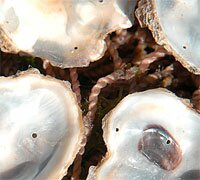| |

Black Sea Mollusca and sea shells
Shell is both the outer skeleton and the house of Bivalve and Gastropod Molluscs. Molluscs grow, and their shells grow with them. Special cells in the edge of molluscan mantle (outer skin) form a crystalline limestone deposit, which adds to the growing shell, making it wider and thicker. Molluscs grow more slowly in winter than in summer, so the rate of shell growth is not continuous, and we can therefore identify annual growth rings on shell surface - just like in the trunk of a tree (growth rings are usually more coarse, less sharp than the normal concentric patterns of certain molluscan shells, e.g. the shells of Veneridae species). Growth rings are better discernible on clam valves, but even the age of a gastropod such as the common Black Sea marine snail Tritia or Rapana can be counted by growth rings.
On normally smooth shells, such as valves of the Black Sea mussel Mytilus galloprovincialis, annual growth rings are not the only things to be seen: every disturbance of the near-shore marine habitat (sea storms, sudden cooling of water, water pollution event etc.) leaves its own ring on the shell because it affects the animal's feeding rate, and - correspondingly - the shell growth rate. Studying the chemical composition of shells - growth rings of the same shell, or shells of the same species from different years or centuries - can provide investigators with information on the chemical composition of the seawater during the corresponding period of time.

metamorphoses of Venus gallina shells:
right - normal coloration,
black shells that have been buried in anoxic sediments where they blackened by interaction with sulfuric hydride;
yellow shells traveled up through the sediment to its surface by the action of waves or currents; black metal sulfides turned into yellow salts after interaction with oxygen;
white shells - protective upper layer of shell rubbed off by sand
|
Venus gallina and Donax trunculus are the most common clams living on the shallow sandy bottom at the Black Sea coast. A lot of their shells are scattered on the beach. Triangular shells of Spisula triangula are also common here. Everywhere on sandy beach are tiny transparent shells of Lucinella divaricata and Lentidium mediterraneum. These are fast growing, short-living annual bivalves. Heavy shells of Scapharca inaequivalis: this tropical clam of Arcidae family colonised the Black Sea in late 20th century.
Left to right: most common Black Sea beach shells
Venus gallina
Cerastoderma
glaucum
Donax trunculus
Scapharca inaequivalis
|
Most clams (bivalve molluscs) inhabit the soft bottom - sand or silt. They hide inside the sediments leaving only siphons - two mantle pipes - sticking out: one for sucking water in, another one for letting it out. Co-ordinated movement of the thousands of cilia (like those of Infusorian) on the surface of ciliate cells on the mollusc's gills make the water flow through the animal; the gills first take oxygen from the water - clam breathing; then the water flow is directed to the mouth of the bivalve. The food of bivalves, which they filter from seawater, is seston - that is, both live plankton and detritus - dead organic particles in suspension. See also Bivalves of the Black Sea - soft bottom habitats
A few species of Bivalvia in Black Sea live on hard substrate: mussels Mytilus galloprovincialis and Mytilaster lineatus fasten themselves with bissal threads to underwater stones, macroalgal stems or pier columns, whereas oyster valves grow into the stone or other oyster shells. Black Sea oyster shells used to be white with a light green or pink tint; now we are finding mostly black oyster shells on the beach because they have spent some time buried in bottom sediments, where they were blackened by sulfuric hydride produced by anaerobic bacteria living in the sediment. The stone drill Pholas dactylus has found another way of settling on hard substrate - when it's not too hard: Pholas makes holes in soft stones, mainly in marly limestone, with its toothed drill-shell. Black Sea Shells - Molluscan species of hard substrates
Pitar rudis lives on sandy bottom at depths greater than 10m. Because of that we seldom find its red-speckled shells on the beach. For the same reason we rarely see Modiolus phaseolinus shells - despite the fact that it is the most abundant molluscan species in the Black Sea; phaseoline silt consisting of disintegrated Modiolus shells is a major type of sediment in the Black Sea shelf bottom.

Life cycle of a marine gastropod, Rapana venosa
|
Marine bivalves and gastropods are bottom dwellers for the most part of their life. But the first weeks after hatching from eggs, molluscan larvae spend within water column; they are microscopic zooplankton animals. The most common gastropod at Black Sea coasts is Rapana venosa; during the spawning period (June to August), white brushes of its its egg cases can be found on any hard underwater substrate. In sandy bottom habitats it is most usual that female Rapana glues fertilized eggs to their mate's shells. Plankton larvae of marine gastropods called veliger swims using cilia, and feed on detritus and smaller plankton; it forms tiny shell, grows, and settles on the bottom two weeks after hatching from egg.
Life cycles and planktonic larvae of other benthic animals - Black Sea zooplankton page
|
Marine gastropods prefer crawling on hard substrates. A green Gibbula snail scrapes periphyton off rock surfaces with its grater-tongue - radula. Very small and beautiful marine snails - Tricolia, Bittium, Nana, Rissoa - live on macroalgal branches scraping periphyton and dead crust cells from them.
Some marine gastropods in the Black Sea such as Rapana venosa and Trophonopsis breviata are predators: they drill into other shellfish shells with their tongue, inject digestive enzymes through the drilled hole, and then eat the flesh digested inside its shell. The large adult Rapana usually simply prises open a bivalve using its strong muscled leg. Rapana venosa eats any large shellfish in the Black Sea: bivalves, other gastropods, crabs; the smaller Trophonopsis predates mostly Modiolus phaseolinus bivalves.
|
Bivalvian diversity in the Black Sea has declined about two-fold since the Rapana invasion in 1947. (About the Rapana venosa Black Sea invasion: Evolution of the Black Sea Ecosystem). Due to ecological pressure from Rapana, many Black Sea bivalves like Cerastoderma spp., Donacilla cornea, Gouldia minima, Loripes lucinalis, Gastrana fragilis, Mactra corallina, and others, as well as some Black Sea gastropods e.g. Patella tarentina have become very rare or completely disappeared. The most beautiful bivalve of Black Sea - Black Sea scallop Flexopecten ponticus is considered extinct: no live specimens have been found since the late 1990s (fresh 0.5 cm scallop shell was found in 2008 near Tuapse, so that mollusc was alive in 2007 at least). Oyster banks no longer exist in Black Sea; a very few live edible oysters Ostrea edulis survive in the Black Sea in narrow crevices inside underwater rocks, or growing on downward rock surfaces where Rapana can not reach them. We still are finding all those shells on Black Sea beaches.
|

Oyster (Ostrea edulis) at Crimean coast, 2005
|
|
Spring 2005 was marked by massive settling of Rapana venosa larvae at Caucasian Coast of Black Sea - unprecedented in at least 30 past years. In May, any hard underwater surface including farmed mussels and oysters shells to the 30m depth was covered by tiny Rapanas, 1-3mm size. Settling density reached 5 gastropods per cm2 at some sites from Tuapse to Anapa.
To the end of September, young Rapana venosa had eaten almost all bivalves (mainly Donax trunculus) on the shallow sandy bottom of the coast strip, and had destroyed 2/3 of wild mussel population to a depth of 35m - rough visual estimate made by mussel farmers and Rapana hunters. Shellfish farmers reported a ca. 50% decline in the mussel and oyster harvest.
|

Pacific oyster Crassostrea gigas shells drilled by young Rapana venosa, generation 2005. Utrish shellfish farm, Caucasian coast of Black Sea
|
Below, and in the two following pages are pictures of seashells from the beaches of Caucasian and Crimean coasts of the Black Sea. They do not represent all the species of Mollusca in the Black Sea , still shells of most of them are there.
Gastropods - Gastropoda - soft bottom - Black Sea
|

Rapana venosa, veined Rapa whelk <15 cm, the largest marine gastropod, and one of most ruthless predators in the Black Sea; it eats bivalves so efficiently that bivalvian diversity in the Black Sea reduced about two-fold since Rapana invasion in 1947. Small-sized Rapana drill bivalvian shells with its radula, inject digestive enzymes inside, and then suck the digested flesh out; they even do the same to crabs! Adult Rapanas just open bivalves with their large versatile leg. There are no predators for adult Rapana venosa in the Black Sea the starfish that normally prey on this gastropod can't tolerate the low salinity of the Black Sea
|

Calyptraea chinensis - Chinese hat <4 cm, one of few gastropods living on the soft sediment bottom; the mollusc is housed in a tiny half-volute of the shell, the rest of the wide shell-cap is needed for staying on a soft surface - like a ski on snow
|
|

Clathrus turtonis <4 cm, a rare species in the Black Sea
|

Trophonopsis breviata <2cm Small predator eating bivalves, living deeper than 20m. It preys mostly on Modiolus
|
|
|

